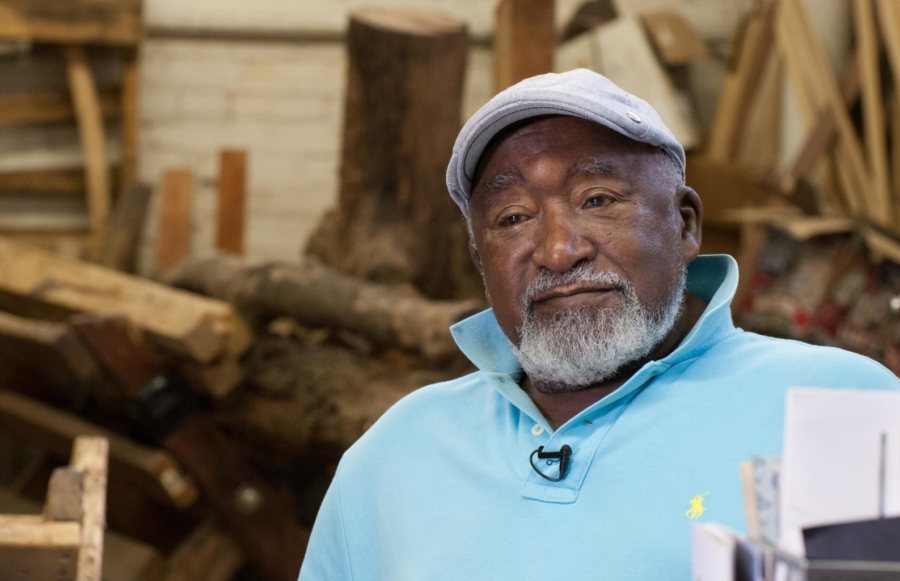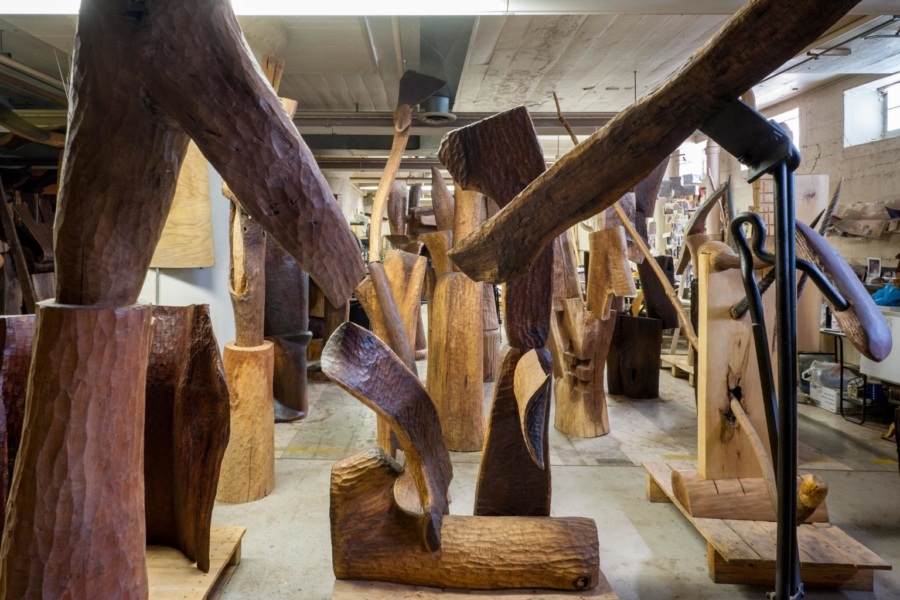April 5, 2018
Download as PDF
View on Carnegie Museum of Art
On a cold Saturday morning in December, sculptor Thaddeus Mosley arrives at his Northside studio, located in an industrial park along the Ohio River. Walking down a short flight of stairs into the basement of a brick building, he opens a breaker box and switches on the lights, illuminating the entire bottom floor. For Mosley, now 92 years old, this space has acted as a second home for nearly two decades.
“I’m here everyday,” Mosley says. “This is what I do. Even when I’m not here, when I’m sleeping at night or going to bed, I’m thinking about what I’m going to do tomorrow in the studio. You [might] say [it’s] an obsession.”
Mosley’s dedication to his craft is ritualistic, almost sacred—observed the same way that some practice religion. And to walk into his studio is like wandering into a solemn, underground forest. His towering sculptures, some of which reach heights of 8, 9, and 10 feet tall, are spread throughout the space. Many give the appearance that they are floating in the air. Others look top-heavy, as if they might fall over at any minute. Yet they never do. Such optical illusions are a testament to Mosley’s skill in carving sculptures that have presence beyond their physical form.
It is mesmerizing to watch sculptor Thaddeus Mosley shape a piece of salvaged timber, his chisel and mallet working in tandem to gouge the wood and give it new form. It’s almost as if his work is an exercise in artful subtraction. As he takes away mass from the timber, bits and pieces of curled wood falling to the cement floor in his studio, he reduces the tree to a more primal form.
Character is a dominant through line in Mosley’s work. Not only in the way that he approaches sculpture—where themes such as life and mortality are conveyed with mallet and chisel—but in the manner that he has nurtured and sustained his art practice for more than six decades. The quintessential working class artist, Mosley’s career is a study in duality, where dedication to family and craft are each paramount concerns.

Thaddeus Mosley in his Northside studio. Photo: Bryan Conley
Born in New Castle, Pennsylvania, in 1926, Mosley served in the U.S. Navy before graduating from the University of Pittsburgh in 1950 with a double major in English and journalism. After college, he settled in Pittsburgh and began a 40-year career with the U.S. Postal Service—work that enabled him to send his six children through college. During the 1950s, Mosley also moonlighted as a freelance journalist for the Pittsburgh Courier and several national magazines, assignments that originally awakened his interest in carving and sculpture. When he began to produce his own pieces, he found inspiration in African and tribal art, and was influenced by the work of Rumanian sculptor Constantin Brancusi and Japanese American artist and landscape architect Isamu Noguchi.
Georgia Gate, a spare but expressive sculpture, was acquired by the museum in 1976 following Mosley’s participation in the 66th Annual Exhibition of the Associated Artists of Pittsburgh. Less than a decade earlier, in 1968, Mosley had exhibited his work in a solo show at CMOA. Among his contemporaries in the Pittsburgh sculpture scene at that time were Virgil Cantini, Aaronel Deroy Gruber, and Robert Lewis Lepper—all of whom have work in CMOA’s permanent collection.

Many of Mosley’s sculptures remain visible in public spaces throughout the city. Phoenix, a 14-foot-tall cedar carving at the corner of Centre Avenue and Dinwiddie in the Hill District; and Mountaintop, a limestone work located outside the Martin Luther King Jr. Library in that same neighborhood, are among his best-known pieces. In 1997, Recent Sculpture by Thaddeus Mosley debuted in the museum’s Forum Gallery—an exhibition that featured such powerful works as Cove for Chillida (1994) and Source—of All Gods and Superman (1994).
Today, more than half a century after he first began making sculpture, Mosley continues to create new work in his studio. The pieces he is currently carving, which partially encircle the area near his main workspace, will be featured in the Carnegie International this coming October.



